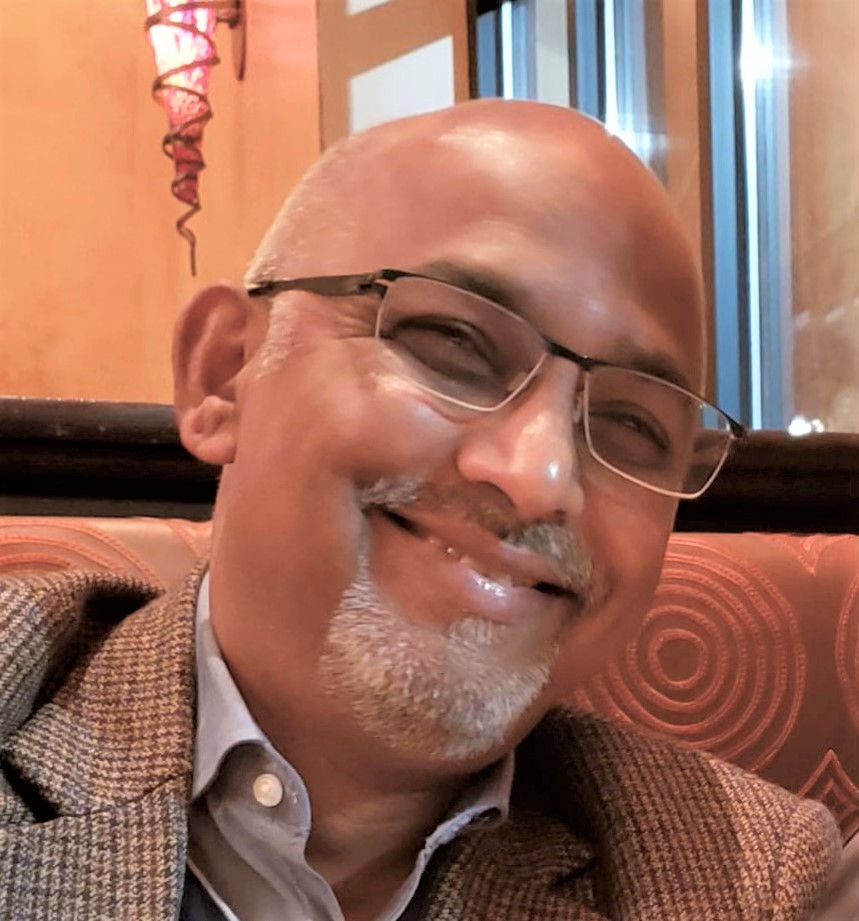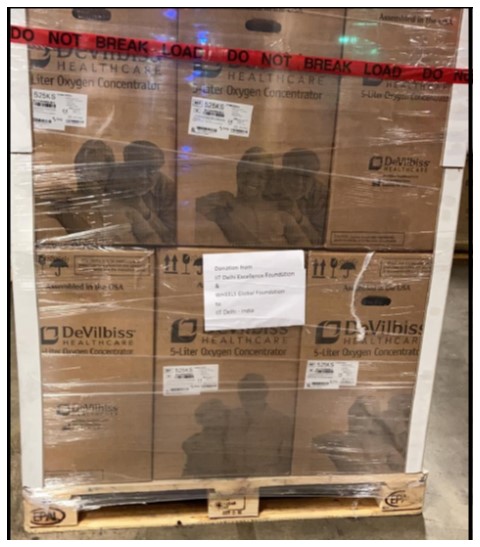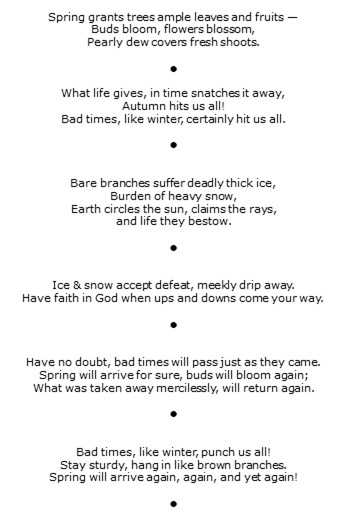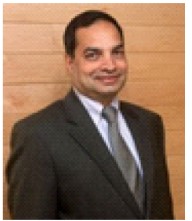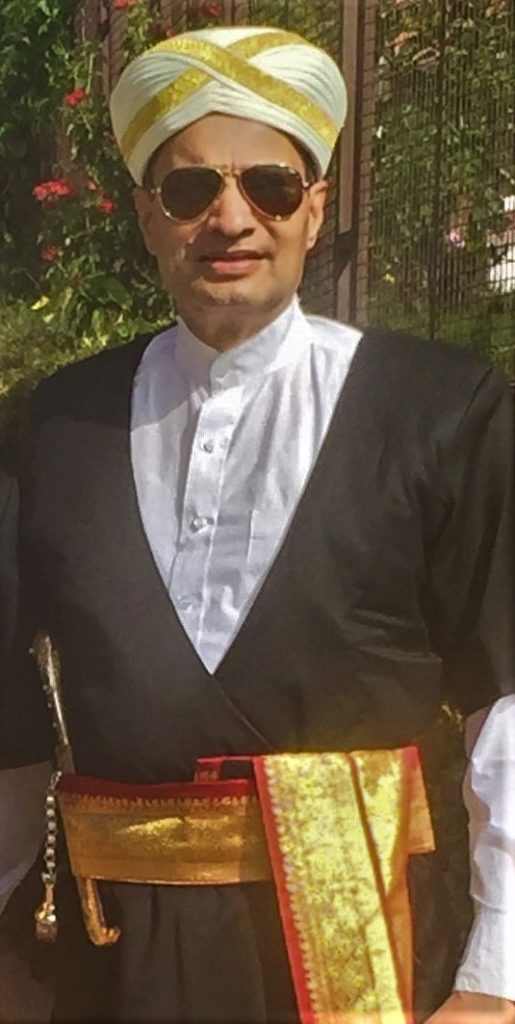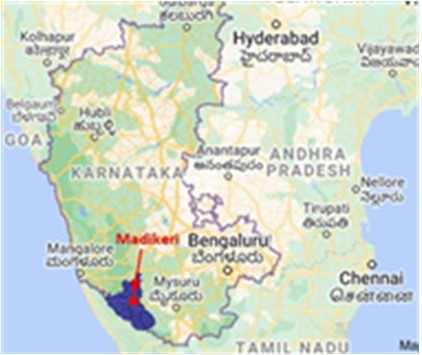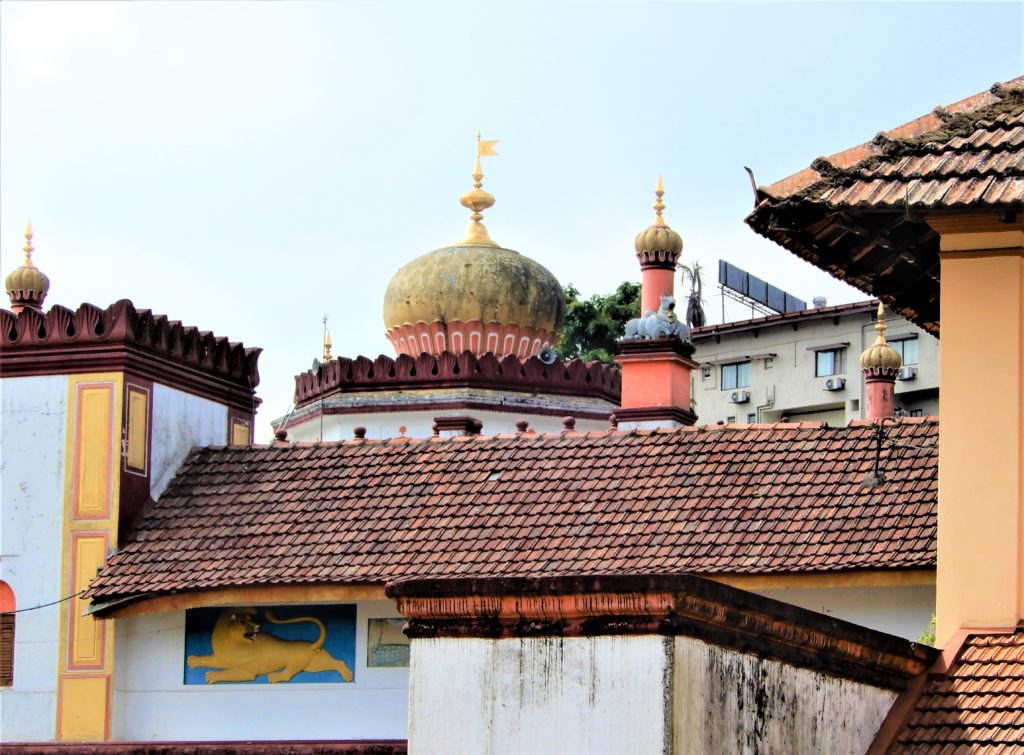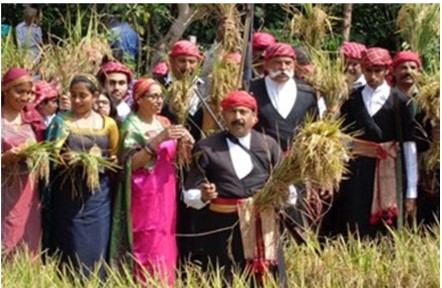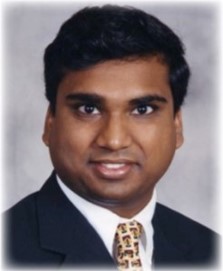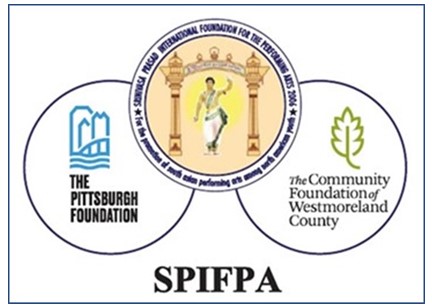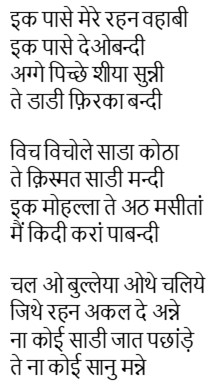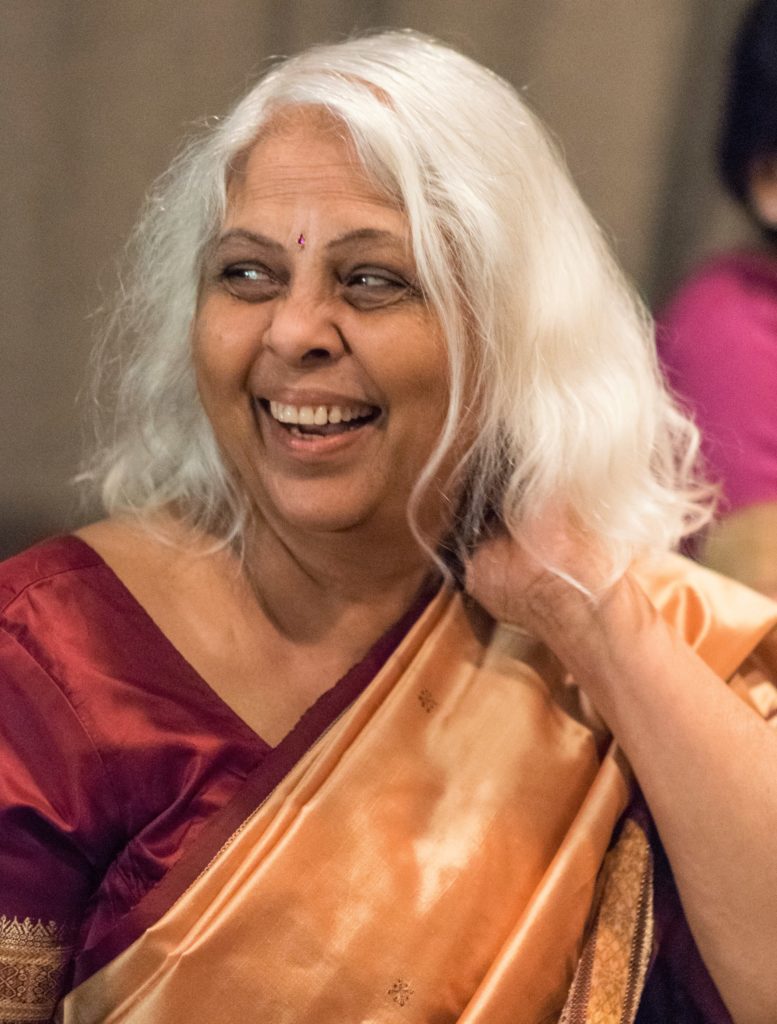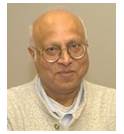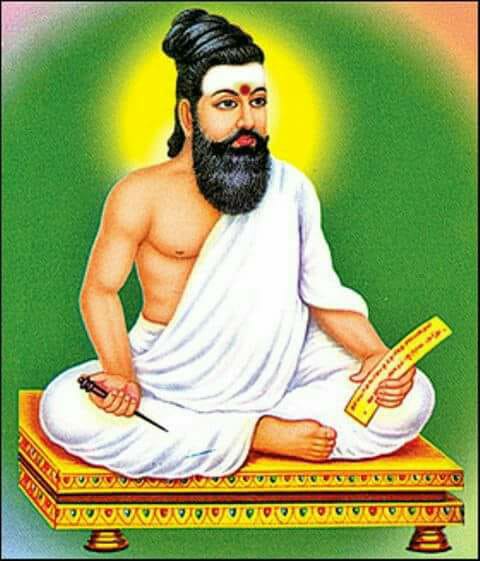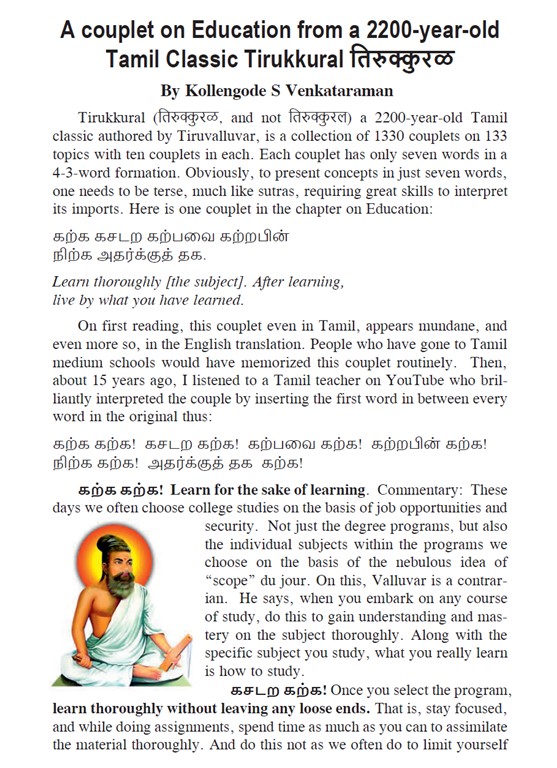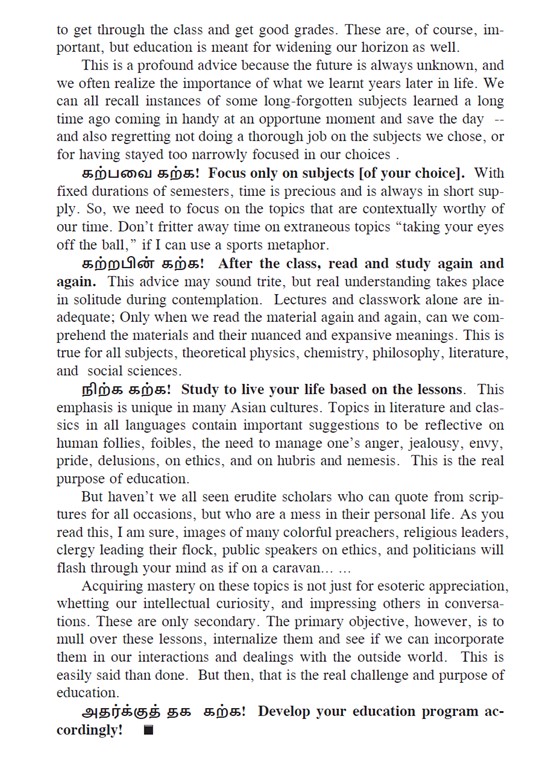Archive for category Past issues
Obituary: Jayesh Selokar (1970 to April 8, 2021)
Posted by admin in July 2021, Past issues on July 1, 2021
By Shesh Arkalgud, Murrysville, PA
Jayesh Selokar, a resident of Murrysville for 10 years, passed away suddenly on April 8, 2021 in Kuwait, where he was on work. He was 51 and the cause of his death was cardiac arrest.
He was born in Rourkela, Orissa. After receiving his electrical engineering degree from Nagpur University, India, he worked at the Bhilai Steel Plant in India before moving to Dubai where he worked at the Dubai Port Authority for 7 years. Then he made his way to Canada before landing in the US.
He married Rohini in 1999, and came to Pittsburgh in 2011. Hewas with the Elliott Group untill his demise. He completed e-MBA from IUP in 2019. He leaves behind Rohini and his two sons, Harshvardhan, 21, and Aryan, 15.He was well-connected with the community through his social ventures and at the Hindu-Jain Temple’s Executive Committee and Humanitarian Committee. He was also active in the Maharashtra Mandal.
Selokar’s mortal remains were brought to Pittsburgh on April 21st and cremated at the Beinhauer Funeral Home on April 22, 2021 with Pandit Suresh Joshi from the Hindu-Jain Temple helping the Selokars with the cremation rites. END
Home:
Pittsburgh Indians Help Sending Oxygen Concentrators to India
Posted by admin in July 2021, Past issues on July 1, 2021
By Sailesh Kapadia, Wexford, PA
In early May, there was an appeal from a government hospital in New Delhi for oxygen concentrators for Covid patients. The nonprofit Wheel Global, a 501c3 organization in Washington DC, and the alumni of the Indian Institutes of Technology received the request. Wheel Global’s inspiration was the late President of India, Dr.Abdul Kalaam, who in 2006 challenged IIT alumni to solve the “big problems facing India, the United States, and the rest of the World.â€
Wheels Global, collaborating with the IIT Delhi Excellence Foundation (IITDEF), ordered from DeVilbiss Co. located in Somerset, PA, all the 434 numbers of the FDA-approved oxygen concentrators available from them at that point. IITDEF and Wheels Global arranged the funds for the product, negotiated prices, and expedited shipping/delivery post-haste.
However, to comply with customs regulations in the US and India, DeVilbiss needed to fasten government-approved labels on each unit and every pallet of 12 units, a time-consuming step.
The coordinator, Himanshu Verma, a former resident of Pittsburgh, now living in Washington DC, asked for help from Pittsburgh to complete the job so that the shipment could go out in time to get on the Air India flight to New Delhi that same day.
When apprised of this need, Jamnadas Thakkar, a long-time entrepreneur and philanthropist in our area, wanted to get this done quickly. He contacted Manoj Kansara, the Financial Manager of a motel in Somerset. Kansara readily volunteered, went to the DeVilbiss plant, and got the job done.
The units were shipped on the same day in time to New Delhi and on arrival at Delhi, were distributed to hospitals in Delhi and IIT Delhi where the remainder of the units were retained for distribution to other needy places in India. For further information visit www.wheelsglobal.org or email suresh@wheelsglobal.org. END
Home:
Spring Arrived — Summer is Here
Posted by admin in July 2021, Past issues on July 1, 2021
The Pandemic Reveals India’s Soft Underbelly
Posted by admin in July 2021, Past issues on July 1, 2021
Simply focusing on the immediate problem and blaming Modi have given the Indian intelligentsia a convenient excuse to evade the serious introspection needed to get to the root causes to fix the problem. But in an unexpected way, the harsh reality came out when Mr. Adar Poonawalla, the CEO of the Pune-based Serum Institute of India (SII), was interviewed by The Times in London in April. Poonawalla’s SII is the No 1 producer of Covid vaccine in India. SII is the world’s largest vaccine manufacturer (over 1.5 billion doses sold in 170 countries), not only for Covid-19, but also for polio, diphtheria, tetanus, and others.
Poonawalla fled to London in April 2021, when powerful people in India threatened him with dire consequences if he did not give them the Covid vaccine ahead of others in direr straits. In the interview Poonawalla said he got menacing phone calls from chief ministers of Indian states, heads of business conglomerates and others demanding instant supplies of the vaccines. This is what he told The Times:
“Threats is an understatement. The level of expectation and aggression is unprecedented, overwhelming. Everyone feels they should get the vaccine. They can’t understand why anyone else should get it before them. The calls begin cordially, but when I explain that I cannot possibly meet the callers’ demands, the conversations go in a very different direction. They are saying if you don’t give us the vaccine it’s not going to be good. It’s not foul language. It’s the tone. It’s the implication of what they might do if I don’t comply. It’s taking control, not letting us do anything unless we give in to their demands.â€
Modi’s government gave Poonawalla the highest-level security detail, but Poonawalla still felt threatened, and fled to London. His company is getting round-the-clock police protection. Poonawalla told The Times: “I’m staying here an extended time… I don’t want to be in a situation where… … you don’t want to guess what they are going to do.â€
This is how the CEO of a company making a critical life-saving drug (desperately needed by over 1 billion Indians) is threatened. You can imagine how ordinary businesses in India are harassed by local politicians subtly demanding protection monies under the guise of fundraising and by senior bureaucrats slyly seeking bribes/favors to get their jobs done. And how millions of street vendors and shop owners routinely grease the palms of local police and low-level bureaucrats to avoid harassment. Businesses matter-of-factly take these bribes as “operating costs,†passing them on to their consumers. Thus, citizens directly bear the brunt of corruption in terms of high costs, and indirectly in terms of the poor quality of products and service for everything.Â
India’s organized sector (large and midsize public and private companies, banks, healthcare, transportation, and others) sits on the loose sand of its unorganized, informal sector — daily wage earners, taxi drivers, domestic help, small farmers, vegetable vendors and millions of nano-entrepreneurs. The unorganized sector’s workers —~80% of India’s workforce — are not well-educated and are aware that most of them are not anglicized enough to ever join the organized sector. This class does not have the bonuses or other savings available to those in the organized sector.
Out of this unorganized sector emerge leaders of raw politics. Those who succeed become elected officials running local, state, and federal governments, jumping ahead of the intelligentsia in wielding raw power. Many also end up in the underworld developing a symbiotic dependence with politicians, industrialists, and India’s polyglot film industry. Consider this: over 2500 sitting members of parliament and state legislatures in India have criminal cases against them.
In this milieu, the Indian middle-class and above have nurtured their lifestyle over the last 50 years, developing a network with their socioeconomic equals and wannabes, with their myopic ideas on neighborhood and obligations to citizens at large. In India, in 2020, with 300 million people estimated to be in the middle class, only 58 million people filed income tax returns, with only 15 million actually paying income tax (www.tinyurl.com/IncomeTaxPayersIndia).
But the World Economic Forum (www.tinyurl.com/IndiaDisposableIncome) reports that even in 2015, nearly 50 million people had disposable incomes of $10,000/year (INR 750,000/year). See the plot below. With income tax levied for taxable incomes more than INR 250,000/year, Indians have perfected tax evasion. In the US, by comparison, 50% of households pay income tax.
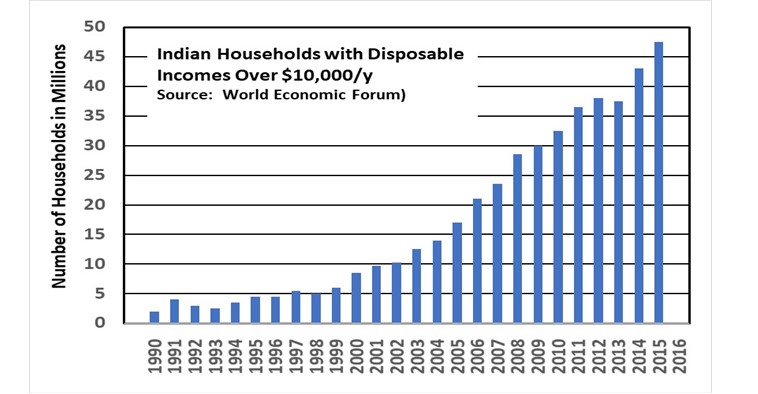
The Indian middle class demands all kinds of service without paying for them through taxes; but it is ever ready to berate governments for the problems du jour, such as the entirely predictable annual monsoon floods; and as is now the case, the Covid pandemic.
In this milieu, the Indian middle class over the last 5 decades has developed a schizophrenic lifestyle. While physically living in affluent parts of Indian urban areas, they mentally live in Amsterdam, London, NYC, Boston, the Bay Area, Dubai, Singapore, Sydney… Like American suburbanites, they insulate themselves from, and are oblivious to, local issues where they live. Because of their access to resources, they are well-informed, often well-travelled, with a network of contacts spread across the world. This class routinely and without any hesitation gets its jobs done ahead of others through their contacts with those in power and influence, or with bribes.
And then, in the second wave of the pandemic, the metaphorical excreta hit the fan, splashing it on everybody’s face. India’s middle and affluent classes are deeply embarrassed and angry. But instead of doing some serious soul-searching on why they are where they are today, they scream at Modi’s central government, making him personally responsible. In reality, though, they have been contributing to the problems for three generations.
Educated Indians do not need any advice from outside experts to fix this problem. The Covid crisis will eventually force them to dispassionately look at themselves and reorganize their society on truly egalitarian ideas they all can agree on. They can study the models of Japan, Germany or the Scandinavian countries, where everybody pays their share of taxes for the state to provide decent education and quality preventive healthcare for all. The goal should be to give opportunities for today’s poor through education and enterprise and make them prosper to become tax paying citizens and thus help governments to pull up people below them.
They will have to abandon the laissez-faire model of unfettered free enterprise, the same way they abandoned the other extreme of the Soviet model state-controlled economy. After trying the Soviet model for 50 years, India had to abandon it when the whole nation was driven to the brink of bankruptcy in the late 1980s.
Everybody must give something to get something in return, both tangible and intangible. They do not have to look too far. They only need to go to their own traditions to learn of the mutual obligations of every segment of society to others. END
Home:
Covid-19’s Second Wave in India
Posted by admin in July 2021, Past issues on July 1, 2021
Note: The author acknowledges Arun Jatkar, Monroeville, PA; Lalit Mohan Gantayet, Navi Mumbai, India; Verghese Chandy, Melbourne, Australia; and K. Suryanarayanan, Chennai, India for their thoughtful review and suggestions on the drafts before it was finalized.
By now everyone has seen them — horrifying images of mass cremations on open grounds in newspapers, and flashed on TV screens across the globe. Gory video clips showed in blatant invasion of privacy, decency, and sensitivity, patients in trauma minutes away from death in crowded New Delhi’s ICUs. They dared not show these scenes that routinely did happen in ICUs across the US a scant ten months earlier. Denigrating India is fair game in the global media.
In April-May the second wave of the pandemic hit the Indian middle and affluent classes as well. The widely reported shortage of medical oxygen, a routine item in normal times, for Covid patients in ICUs only accentuated the issue. The polyglot voices of politicians and opinion writers in the ratings-driven Indian media understandably pinned down Prime Minister Modi, berating him for everything that went wrong.
What the Indian media, or international media, did not highlight is the lackadaisical response of state governments and the profiteering attitude of the profit-driven private hospitals that led to the oxygen shortage. Here (www.tinyurl.com/GurumurthyO2) is a story on how the shortage was precipitated by profit-driven private hospitals.
Here (www.tinyurl.com/GulfNewsOnModi) is another story discussing whether the Modi government was negligent. The drift of this article is that a) the Modi government did anticipate the second wave, and did warn state governments; b) opposition parties did not want the Modi government to ban open election rallies during the pandemic; and c) the Modi government expanded the medical infrastructure (isolation beds and ICUs) by several multiples during the pandemic. Granted, whatever was done was not adequate given the enormity of the pandemic.
India’s pandemic crisis needs to be seen in the global context. See the table below.
Mortality Table for Select Countries (data from WHO)
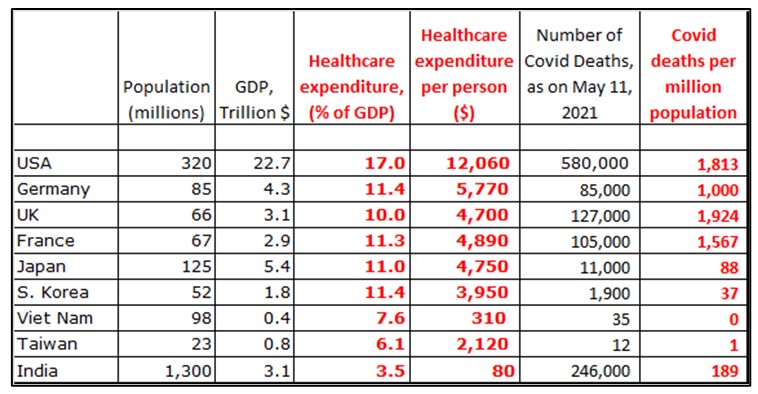
• The US and the industrialized West, despite its high GDPs (column 3), high expenditure on healthcare as a % of its GDP (column 4), high per-capita healthcare expenditure (column 5), high standards of living, and far better healthcare infrastructure than the rest of the world, did poorly in managing the Covid pandemic (last column).
• Taiwan, South Korea, Japan and Vietnam, neighboring China from where the Covid pandemic originated, responded much better than the industrialized West. Compare the numbers in the last column. Vietnam is a developing economy. What did they do right that the West did not, and did we learn anything at all from them?
• In India, the officially reported mortality rate is ~200/million, even with its poor investments in healthcare (more on this later). It is quite possible that India under-reported or misclassified its mortality numbers. Even if we assume India’s actual mortality rate is twice, or thrice (that is, 100% or 200% more), it would still be ~400/million or ~600/million, not anywhere near the more than 1,800 deaths/million in the US.
• But with India’s free, confrontational media hostile to Modi, and with NGOs everywhere, deliberate large-scale suppression of Covid mortality data is not easy in India’s federal system of governance. All Covid-positive diagnoses and deaths nation-wide have to be immediately reported to the Indian Council of Medical Research that gathers and collates all raw data and keeps a close watch on this pandemic’s spread.
India’s Healthcare System:
In the Indian constitution, healthcare is a state subject with democratically elected governments driving the healthcare policies in each state. This is because of India’s demographic diversities in every metric and wide variations in available resources and priorities. With disparate political parties at loggerheads with each other running the 30-plus state governments, massive, deliberate fudging of covid mortality numbers would be difficult for the federal government.
The profit-driven Indian healthcare industry is unregulated, modeled after the American pay-per-service system (but without any oversight). Private general practitioners are at the bottom of the pyramid with specialists in the expensive super-specialty hospitals at the top.
The poor/working poor go to the inadequately funded, poorly equipped, and badly managed government hospitals for all their needs; in these hospitals, the service is free, but far from satisfactory. Government hospitals train new doctors with dedicated senior clinicians drawn by the challenges to serve the poor.
The poor cannot afford expensive pay-per-service private doctors. Consider this: tertiary medical care for a knee replacement + 2-week hospital stay costs INR 500,000 to 700,000 in a second-tier private hospital, way beyond the reach of working-class Indians earning and spending in rupees. The middle class go to private doctors and private hospitals they can afford. The rich go to the expensive super-specialty hospitals.
The Covid pandemic brought out many depressing features that have been festering for nearly six decades in India’s healthcare sector, with both omissions and commissions by different segments:
• Poor investment decisions in public health and primary care by state governments for over 70 years (Modi came to power only six years before the pandemic exploded).
• Unregulated pharmaceutical and medical supplies industry — many of them multinational companies based in the EU and the US.
• Practicing physicians owning medical labs with vested interests.
• The high cost of medical education in profit-driven private medical colleges run by politicians under the rubric of tax-exempt foundations. The cost of fees plus books and supplies in a profit-driven private medial college for a five year program exceeds INR 10,000,000 (or 1 crore rupees). To this you need to add the cost of boarding and lodging. Freshly minted doctors coming our of medical colleges with this kind of “investment” are in a great pressure to recover the money as quickly as possible.
• Low tax base for the governments (more on this later); and
• The sinister practice of unethical, illegal payments permeating the entire healthcare industry.
The last item is pernicious and needs some elaboration:
• All drug companies — European, American and Indian — bribe doctors in India for prescribing their medications on a prorated basis. The more you prescribe, the more you get as bribe.
• Specialists bribe general physicians to refer patients to them.
• Labs bribe physicians and surgeons to refer patients to their labs for blood work, pathological tests, and X-rays, CT-scans, etc.
• Hospitals bribe doctors for referring patients into their facilities.
• Often the doctors themselves own these labs, tempting them to order more tests than what are needed.
All these unethical and illegal payments are deviously transferred to patients, who often do not have health insurance and bear 100% of the cost from their own pockets. These payments can be up to 40% of the final costs. The unscrupulous ways in which India’s healthcare industry — doctors, European, America, and Indian pharmaceutical companies, hospitals and medical labs — bilks helpless patients in India are well-known.
So, the industry of healthcare delivery is predatory and exploitative throughout India. Often, the interactions are hostile between private doctors and patients (who bare 100% of the cost of the medical care out of their own pockets). This is because of the lack of trust between the doctors and the patients when it comes to the need for tests, and how much they will be charged.
Thus, the impenetrable thicket of India’s healthcare industry is sustained by a mutually exploitative dependence among all segments of the unregulated healthcare system with no oversight. This system has been ripping off the hapless patients for over 50 years. No wonder there is no incentive for preventive and primary care in Indian healthcare system. END
Home:
Ha! Ha! Ha!
Posted by admin in April 2021, Past issues on March 26, 2021
Every society has its idiosyncrasies that fascinate outsiders. But when these come in quick succession, it is amusing. That was my reaction on the four news items coming in quick succession in Pakistan’s daily Dawn:
◠Dawn, February 16, 2021: The Islamabad High Court orders razing of “illegally constructed†lawyers chambers in Islamabad.
The Court in a unanimous verdict ruled that the offices built for lawyers on a sports ground in Islamabad were “illegally constructed†and therefore should be razed by the relevant authorities. The verdict was announced by a four-judge bench headed by the chief justice himself.
The verdict said lawyers who allowed the building of the chambers “forcefully [took] the law in their hands…†and added, “The facts of this case are disturbing because the conduct of a few lawyers has caused reputational damage to the entire legal fraternity.â€
â— Dawn, February 18, 2021: “Three injured after fight breaks out between two groups of doctors in a hospital.”
This happened in the city of Gujrat in the Sindh Province in Pakistan. Three people were injured after a fight broke out between two groups of doctors at the Aziz Bhatti Shaheed Hospital. A police official said four people were arrested and two weapons seized from them.
A former president of the Pakistan Medical Association told the media, “We were attacked by [one] Dr Usama Talat and his companions, [who] tortured our doctors.†Making matters worse, he alleged that the police official at the scene, “instead of sorting [out] the matter, inflamed it further†by facilitating the escape of the other group from the scene.
â— Dawn, February 19, 2021: “Politician in custody claims a cobra was deliberately left in his jail cell to kill him.â€
The Leader of the Opposition in the Sindh Assembly Haleem Adil Sheikh claimed that a 4’-long black cobra was in the lock-up room, deliberately left in his cell to kill him on the directives of Pakistan People’s Party chairperson Bilawal Bhutto-Zardari and Sindh Chief Minister Syed Murad Ali Shah. Mr. Sheikh was in custody for violence, firing guns, attempted murder and causing terror during by-elections in Karachi.
One commentator wondered whether the snake was also afraid of Mr. Sheikh in the prison cell.
The grand finale in this thread was this: Dawn, March 9, 2021: “Five courts [were] illegally built on private land, Supreme Court [was] toldâ€
Pakistan’s Supreme Court was informed that as many as five courts have been built illegally in Islamabad on private land. This was disclosed in response to the apex court’s directives in a case related to privately owned lands for a soccer field.
— By K S Venkataraman END
Thank You, Contributors ! An Update on Contributions (as of Match 22, 2021)
Posted by admin in April 2021, Past issues on March 26, 2021
Editor: The Patrika profoundly thanks contributors for responding to our appeal for monetary contributions for continuing with the magazine. As we explained in the October 2020 issue in two articles here and here, our advertisers simply vanished last year at the peak of the Covid-19 Pandemic. As you all know, with no subscription, we depend EXCLUSIVLEY on advertisements, for meeting the expenses for creating, printing and mailing the magazine for 1800-plus homes.
After suspending our magazine for two issues, we again started in October last year.
Given below are the up-dated alphabetical listings by last names of contributors for the Pittsburgh Patrika to tide over the Covid Crisis. The details of contributors prior to December 10 2020 are available here. Again, as before, at the request of donors who wanted to remain anonymous, we truncated their names with ellipsis (… …)
The lists below detail those who contributed between December 10, 2020 and March22, 2021.
Contributions By Checks Reported in This Issue:
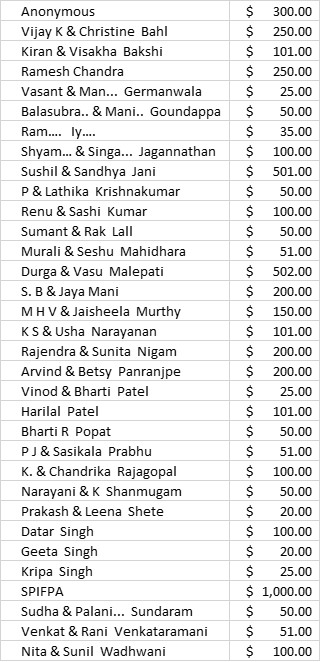
Subtotal of By-Check Contributions: $4959.00
Online Contributions Reported in This Issue:
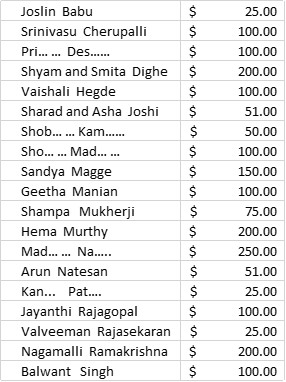
Subtotal of On-Line Contributions: $2002.00
___________________________________________________________________
Please go to www.tinyurl.com/SubscribePatrika and make their contributions on-line for us to meet our target goal.
Home:
Contributions as of Dec 10, 2020:………………………. $11,983.00
Contributions reporting in this issue By Check:………….$4,959.00
Contributions reporting in this issue On-Line: …………..$2,002.00
ALL Contributions as of March 22, 2021: ……. $18,945.00
Target for the fundraiser: …………………….. $20,000.00
Thank all of you once again for your generosity!
END
Matrimonial Bliss & Love NOT Canceled
Posted by admin in April 2021, Past issues on March 26, 2021
By Erin Calvimontes, Divine Celebrations
Editor: Erin Calvimontes, owner and certified/accredited lead planner at Divine Celebrations, specializes in South Asian/Ethnic wedding planning, coordinating, and consulting. www.DivineCelebrations-Events.com. Contact details: e-mail: erin@DivineCelebrations-events.com or Phone: 412-436-0337
Weddings were happening in 2020 and in early 2021 through the Covid pandemic, and are still happening even now. However, they look different — with smaller and more intimate groups. Rest assured, Matrimonial Love won’t be canceled!
I am happy to announce that as of April 4th, 2021, the State of Pennsylvania has lifted the restrictions, and increased the event capacity! Indoor events are permitted at 25% of max occupancy and outdoor events are permitted at 50% of max occupancy. This applies to events even in your own backyard.
Included in the head counts for occupancy are, obviously, the members of your immediate family and guests. But you must also count all venue staff such as banquet captain, waiters & servers, bartenders, catering staff, and all vendors present — including priests, photographers, videographers, DJs, and planner team.
For the protection of everyone in the gathering, invitees and guests need to understand and observe these practices:
◠Guests must be seated if they have a drink. No standing close to each other or mingling without masks. Guests are expected to wear masks when not seated — like when standing at the bar, being on the dance floor, and standing at the buffet line.
◠Food service has changed as well. All servers must wear masks and gloves. Passed hors d’oeuvres must be handed to the guests by the server or set out on individual plates for guests to take.
◠Buffets must have servers serving, cafeteria style, so as to avoid guests handling the utensils, ladles, spatula… …
â— Guests are expected to physically distance from others while in line.
DJs too have adapted for their and everyone’s safety: They stand behind Plexiglas surroundings for their areas and ask guests to TEXT them music requests!
There is light at the end of the tunnel, and we all need to do our part to keep each other safe and healthy, even as we enjoy these auspicious occasions. Please contact your hosts, Divine Celebrations, or your wedding planner to help you get through all the new restrictions. END
Kodagu — Paradise in the Indian Western Ghats
Posted by admin in April 2021, Past issues on March 26, 2021
By Bidanda Bopaya, Fox Chapel, PA
As the son of an Indian naval officer, Bidanda Bopaya was born in Pune, has lived all over the Indian coastline, and was sent to a boarding school in Ooty at a young age. His wife, Louella, daughter of an Indian air force officer, is a psychologist in private practice. The Bidandas moved to Pittsburgh in 1987 after graduate work at Penn State and have raised two children in the Burgh. Their daughter, Maya is pursuing a PhD in finance & economics after an early career on Wall Street, and their son Rahul is an engineering graduate from Pitt. The Bidandas live in Fox Chapel. Bopaya, a professor of engineering at the University of Pittsburgh and President of the Institute of Industrial & Systems Engineers, has authored/edited 13 books in the subjects of his specialization. Here is Bopaya in his contemporary dress and also in the traditional Kodava attire.
Editor’s note: My early childhood was in Madikeri (earlier name Mercara) in Kodagu District, earlier known as Coorg (population: over 500,000 people) in Karnataka State. Madikeri is the headquarters for Kodagu and the home of the Kodavas, a small, accomplished, and colorful community in the Indian social tapestry. Kodavas are ~20% of the population of Kodagu District, and have contributed disproportionately to India’s armed forces, sports teams, and other professions including as India’s first female ambassador, India’s first PhD in sports medicine, the founder of the National Institute of Sports in Patiala, and of course, India’s first Commander-In-Chief (Gen. Kodendera Subbayya Thimmayya), and India’s first Field Marshal Kodendera Madappa Cariappa
After sixty years, I chanced to drive through Madikeri. I had a vague memory of Omkareshwara Devasthana, a Shiva Temple there. Since it was the only temple I knew in my childhood, it made no impact then. When the driver showed me the temple from a mile away from the hills, I told him it looks like a mosque. His reply: “Illa saar, iduve devasthana.†(No sir, this IS the temple.) Stunned at the unique architecture for a Hindu temple with a typical Islamic dome including the four minarets, I stood in silence in front of the temple absorbing the ambience.
Then during the Patrika fundraising, I saw one Bidanda Bopaya as one of the on-line contributors. From the name, I recognized he is a Kodava (known earlier as Coorgis). I contacted him with my Madikeri roots, and one thing led to another in our exchanges, which finally culminated with Mr. Bopaya writing this article for the Patrika. — Kollengode S Venkataraman
The Omkareshwara Temple is a picturesque and unique place of worship in Madikeri, the heart of a salubrious and verdant hill station in Karnataka. Our family spent summers in Kodagu, and the place remained a well-kept secret because of the absence of a railhead. Now, it is a weekend getaway to Bangalore IT techies arriving in hordes.
Steep hills studded with vibrant homes surround the temple. Legend has it that the Raja of Kodagu, Lingarajendra II, built the temple repenting for some terrible act he committed. He was advised to build a Shiva temple that would awe people, “as long as the sun and the moon are around!†He commissioned the temple, consecrating it in 1820, with a Shivalinga brought from Kashi enshrined at the temple’s sanctum.
Omkareshwara Devasthana is the only known example of a Shiva temple — for that matter, any Hindu temple — built like a mosque with four turrets (or minarets) at each corner and a dome at the center. The rationale for this one-of-a-kind architectural style (Islamic with a Gothic touch) for a Hindu temple is not precisely known even though the temple is only 200 years old, given the frosty relations between the Kodavas and Muslims, thanks to Tipu Sultan (1750-1799), who repeatedly invaded and unsuccessfully tried to take control of the region. Search the web under Tipu Sultan and Kodavas to get multiple perspectives of this complicated relationship.
Given today’s strife-ridden global situation among all religions, it is inspiring that one Hindu temple integrated multiple styles of architecture into its place of worship two centuries ago. As children, we played hide-and-seek with our extended family around the temple.
The Raja’s tomb located nearby, built in 1809, also has an Islamic architecture. My great-great-grandfather Bidanda Bopu was the Commander-in-Chief of the Kodagu Raja’s army and is buried next to the Raja. Growing up, our family often celebrated festivals and visited the tomb to pay respects to our ancestors.
The Kodavas are proud people and maintain unusual traditions. Kodagu is often called the land of generals, beautiful belles, coffee, cardamom, pepper and honey, all because of its hilly terrain and suitable weather, honey, large number of military leaders, and charming and gracious women! Some interesting features of Kodavas
â— Are Kodavas Hindus? While Kodavas are governed by the Hindu laws, they are technically not Hindus, with the absence of a caste system; Kodavas are ancestor- and nature-worshippers. Most festivals are centered around agrarian and martial themes and traditions. However, many Kodavas have now adopted a Hindu lifestyle and traditions.
KODAVA FESTIVALS: Kodavas are rooted to their land as farmers and agriculturists. No wonder, all Kodava festivals are around farming.
â— Kailpodhu: After the paddy fields are transplanted in early September, Kodavas worship their weapons and tools, after cleaning and decorating them. This is followed by festivities (shooting competitions, athletic prowess, while feasting on spicy food and copious alcoholic beverages). Kodavas have the right to bear firearms and weapons without license.
◠Kaveri Sankramana: The river Kaveri originates in Kodagu District in a small natural spring in Bhagamandala, close to Madikeri. In mid-October, at a specified time, the sacred River Kaveri — yes, for Kodavas in particular, and for all Kannadigas, Kaveri is sacred — renews with new divine springs gushing towards a larger body of water. This is the birthplace of the river. People take dips in this holy water. Goddess Kaveri is then worshipped in Kodava homes with youngsters touching the feet of elders for blessings. Kaveri is perhaps the most common name for girls among Kodavas. This is the only meatless festival among Kodavas!

◠Puttari (meaning New Rice), is the traditional harvest festival, celebrated in early December when people gather in their traditional family home (ainé mané) nicely decorated with farm motifs. Like Onam, Pongal, Lohri, Baishakhi, Bihu, and of course, Thanksgiving here, special culinary items are prepared. An important part of this festival is the matriarch of the family leading others into the fields for a symbolic first harvesting of rice paddies.
In addition to these, individual villages have temples that celebrate colorful festivals, including walks thru hot beds of coals. The best way to experience these is to be with Kodavas in their home during the season.
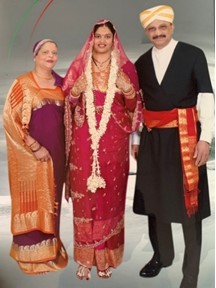
Pittsburgh residents, in traditional Kodava
dress and jewelry at the wedding of their daughter Kaveri.
◠Is there a Kodava cuisine? Yes, of course. Kodava cuisine is replete with unique and fiery dishes including Pandhi Kari (pork curry cooked in a special vinegar), Baimblé Kari (bamboo shoot curry), mangé paji (mango chutney), kuru kari (kidney beans, green beans, in a coconut gravy), akki rotti (rice chapattis) …… the list goes on!!
◠Kodava music, dance and dress are unique and are on display at weddings and festivals. Kodava women elegantly drape themselves in a unique style in standard 6-yard saris. Men wear black wraparounds (kupya), colorful sashes (chalé), and daggers (peeché kathi).
â— Interesting fact: No priests at Kodava weddings. Family elders lead all the religious rites, with a frenzy of Kodava dancing, pandhi curry, libations, and ceremonies steeped in family traditions.
Websites offer a ton of information on tourism-related questions on Kodagu — places of interest, cuisines, lodging, what to do, how to reach, the best time to visit. One website is: www.coorgtourisminfo.com. END
SPIFPA — From the Pains of Grief to an Arts Foundation
Posted by admin in April 2021, Past issues on March 26, 2021
Editor: Drs. Varaprasada Rao and Parvathi Gutti, well-known here for over 40 years, have been patrons of the Indian performing arts in many capacities. This write up is based on information available from the Guttis and other published sources.
The Srinivasa Prasad International Foundation for Performing Arts (SPIFPA), founded in 2005 as a 501(C)(3) nonprofit organization, is familiar to most art lovers in our area. SPIFPA was established in memory of the Guttis’ beloved son ‘Vasu’ (Srinivasa Prasad Gutti) to fulfill his dream. Vasu loved Indian performing arts and had a passion and vision to propagate them among North American youth.
Starting from childhood, Vasu learned Kuchipudi and Karnatic music from legends: late Guru Padmabhushan Vempati Chinna Satyam, Kalarathna A.B. Bala Kondala Rao and Dr. Kamala Rajupet, late Padmasri Pemmaraju Surya Rao, Mandapaka Sarada, late Nedunoori Krishnamurthy and late Nookala Chinasatyam. He earned several awards for his talents both here and in India.
Vasu excelled in his studies. He received the Westinghouse Family Scholarship and the Chairman’s Award in Biomedical Engineering at Case Western Reserve University (CWRU). He was to begin his medical program in 2004 at CWRU with a full scholarship. He was kind and gentle, always ready to help others. Unfortunately, on Memorial Day, May 31, 2004, Vasu died in a ghastly, freak auto accident while he was returning after his recital at the Chicago Tyagaraja Festival.
Since 2005, SPIFPA has been organizing cultural festivals featuring Indian classical music and dance every other year in Vasu’s memory. Further, providing permanent footings to its efforts, it established endowments in India and USA at 1) Sidhendra Kalakshetram, Kuchipudi AP; 2) Potti Sriramulu Telugu University, Hyderabad; 3) The Music Academy, Chennai; 4) Sangeeta Sanmandali, Vijayawada, AP, and 5) Case Western Reserve University Cleveland, Ohio. It also sponsors annually, the Spirit of Youth Festival in Vasu’s memory at the Chennai Music Academy.
In Pittsburgh, SPIFPA as the lead sponsor of Dhirana, the annual national intercollegiate competition in Indian classical dance organized by the University of Pittsburgh’s Indian classical dance team Nrityamala. judges and presents awards (a citation and $500 gift) to the top two teams.
Recently the SPIFPA board approved initiation of the “SPIFPA Advanced Student Fellowship award†for a student producing a “White Paper†on a South Asian performing art of their choice. The two-year project with a significant stipend will document the origins of the art form, the patrons and gurus that contributed to its evolution in India, and the challenges it faced in transplanting the art form in North America.
At the Valley School of Ligonier in Pennsylvania, Vasu was the valedictorian in his graduating year. Recognizing Vasu’s achievements and his passion to promote the arts, the board of directors at the school in 2020 approved to naming stage of the auditorium as the “Vasu Gutti Performing Arts Stage†with his portrait displayed. Every year, the school will host a visiting South Asian artist to perform at the school. This is a significant recognition for the Indian community here. A $1000 honorarium from SPIFPA is under consideration for the artist.
Over the years has SPIFPA partnered with the Community Foundation of Westmoreland County (CFWC) and the Pittsburgh Foundation to promote South Asian performing arts.
In the cultural festivals SPIFPA organizes, accomplished teachers and artists are recognized, and promising students are encouraged to preserve and propagate the arts forms. Here are the artistes SPIFPA has honored and recognized since 2010:
◠Lifetime Achievement Award: Rathna Papa and Revathi Satyu, both from Houston, TX) — Commemorative Plaque & $1000 honorarium.
◠Ambassador Performing Artist Award: Jaya Mani (Pittsburgh PA), Sithalakshmi Madhavan (Pittsburgh PA), Sasikala Penumathi (Atlanta GA), Kamala Reddy Rajupet (Pittsburgh PA), Anuradha Nehru (Washington DC), Mythili Prakash (Los Angeles, CA), and Manu Narayan (Hollywood CA) — Commemorative Plaque and $1000 honorariums).
◠Youth Artist: Madhav Iyengar (Pittsburgh PA), Pallavi Mulukutla (Pittsburgh PA), Sarang Mulukutla (Pittsburgh PA), and Sundararajan Venkataraghava (Philadelphia PA) — Commemorative Plaque and a $500 gift.
◠Child Artist: Sia Iyer (Pittsburgh PA) — Commemorative Plaque and $500 gift).
SPIFPA will continue to conduct cultural festivals and special events to inspire accomplished artists and youth. SPIFPA appreciates the support and participation of all art lovers in its efforts to promote South Asian performing arts among North American youth. For additional details, please contact 724-309-7340 or spifpaorg@gmail.com. END
Indian Thoughts against Religious Exclusivity through the Centuries
Posted by admin in April 2021, Past issues on March 26, 2021
By Kollengode S Venkataraman thepatrika@aol.com
The details of the life of Bulleh Shah (or Syed Abdullah Shah Qadri), the 18th century Sufi poet of the Punjab region in the Indian subcontinent are not precisely known. Scholars believe, he was born in Bahawalpur in 1680 and died in Kasur in 1757, places in the Pakistani Punjab today.
In Bulla’s time, the Punjab region was in social, cultural, and political turmoil, with Aurangazeb (1658-1707) in Delhi and with armed raids from the west by Nadir Shah and Ahmad Shah Abdali (1747–1773). The Sikhs, suffering the most from the brutality of the Mughals and from violent incursions from their western borders, were asserting themselves. Even within Islam, there was strife for control among the different factions.
Growing up and living in this era, Bulleh Shah, as we see in his poems in his mother tongue Punjabi, was disillusioned with the religious bloodletting even within Islam.
I heard one of his verses two years sometime back on YouTube (www.youtube.com/watch?v=gY41LNcSTiM). My Punjabi is zero, yet I could catch the first two lines. Having read earlier Bulleh Shah’s ideas on the Godhead, I could guess where he was leading to.
So, I asked Juginder Luthra, familiar to the Patrika readers, to get the verse in the Devanagari script and also to translate the verse into English.Mr. Suhendra Singh Ajmani, through Shri Sucha Singh, the Granthi Sahib at the Monroeville Gurudwara, got the Punjabi poem in the Gurumukhi script. Here is Bulleh Shah’s poem in translation dripping in disillusionment, sarcasm, ridicule, and anger, all rolled into one:
On my one side live Wahabis,
On the other, Deobandis;
In front Shias and behind, Sunnis,
All live in strict schism restrictions
In the midst of this is our house.
What bad luck!
One village — eight mosques!
Which one should I follow?
Get up Bulleya! Move to a place,
Where live those with blind mind,
Where no one recognizes my caste,
Where none has to agree with me!
Here is the original in the Gurumukhi and the Devanagari scripts:
..
Kabir Das (15th century) similarly shows his disgust on the polemics between Hindus and Muslims of his time.
Rebelling against religious exclusivity has a long history in the Indian subcontinent, as we can see in the Bhakti literature all over the subcontinent. Here is a nuanced example in Tamil, from Kamba Ramayanam (10th or 12th century work), by the great Tamil poet Kambar:
Background: Hanuman is on his way to Sri Lanka to know the whereabouts of Sita. On his way, he has to cross over the Arundhati Hill Range with its peaks protruding into the skies like the palisades. Hanuman’s advisor, knowing that the mountain is dangerous to cross over, advises him to go around the hills. To describe the difficulty of crossing over the mountains, Kambar uses an unusual imagery:
Translation: This hill range is as difficult to fly over “as it is difficult for those ignoramus people to get moksha (liberation from bondage), who bicker on who is superior — Shiva or Vishnu.â€
What made Kambar to use such an unusual imagery? I can only surmise: in Kambar’s time (several centuries before Bulleh Shah), the followers of Shiva and Vishnu in the Tamil country were bickering between themselves in diatribes that must have disgusted Kambar. So, Kambar weaves a contextual imagery to subtly let people know how he feels on the futility of such tirades.
So, the expressions and imageries portrayed in these rebellious poems are always contextual for the place, time, and situation. Here is another example by the 14th century(?) Sivavakkiyar, which holds true for all times, all faiths, all places and all situations:
Your God and our God — Really two are there?
Is not the Primordial One here, there, and everywhere?
When the Primordial One is here, there, and everywhere,
Let them rot and perish, those who differentiate!
This type of theological squabbling is the bane among believers both of different faiths, but also within any one faith all over the world, including Christendom. The long history of the splintering in Christendom is gory since it was also tied to temporal and political power. In early centuries, Catholics (from Rome) and the Eastern Traditions (Greek, Russian, Serbian, and Syrian orthodox churches) were the main groups. But in the 16th century, the Church of England and the Lutherans in Germany broke away from Rome for different reasons. These Protestants later splintered into a large number of subgroups — Anglicans, Evangelicals, Mennonites, Charismatics, Fundamentalists, Baptists, Seventh Day Adventists, Methodists, Pentecostals… with constant bickering.
Consider this: Monroeville (population 28,000) in the eastern suburb of Pittsburgh, has 24 churches belonging to different Christian denominations and three Hindu temples. Imagine what Bulleh Shah would say if he were to visit Monroeville today!
But nowhere in the world, it seems to me, did the free spirits on spiritual matters have as much freedom to express themselves uninhibitedly as they had, and still have, in India. I say this because these types of unorthodox poems are recited and elaborated even today in Gurudwaras, Hindu temples, in kirtans, and in discourses all over India.
This is something the Occidental minds — both native Europeans and the Europeanized Indians — often fail to grasp. This is because, many of them, particularly the Europeanized Indians, have no grounding or familiarity with India’s many languages and its long spiritual journey and its many literary traditions. END
Home
Obituary: Bhanumathi Pandalai (1945 — December 22, 2020): Friendly, Gracious, Elegant, Enterprising
Posted by admin in April 2021, Past issues on March 26, 2021
By Premlata Venkataraman thepatrika@aol.com
Bhanumathi Pandalai, a long-time resident in our area, well-known to many, and my good friend and inspiration for over three decades, died on December 22, 2020 from complications of breast cancer. She was 77.
Bhanu was born on February 10, 1945, in Thenkara, in Palakkad District, Kerala to Sri P.K.C.Raja and Smt. Sreedevi Kovilamma. She attended Zamorin’s Guruvayurappan College in Kozhikode, founded by her extended family in 1877. Her undergraduate degree, earned when she was 19, was in mathematics, with minors in physics and chemistry. She married Krishnan Pandalai in 1965 and arrived in the US in 1966. They moved to Pittsburgh in 1973 after living in Ohio and New Jersey.
Her love of Karnatic music made her a connoisseur of the arts. She and her husband hosted musicians and dancers — both celebrated and little known — in their home for weeks during their concert tours. She was well versed in Sanskrit and Malayalam poetry and prosody. We reveled in her reciting from memory Sanskrit and Malayalam poems in complex meters. In concert halls, she chuckled when Karnatic vocalists mangled lyrics.
While many grapple with issues of identity when migrating to foreign lands, Bhanu seamlessly combined elements of contemporary and traditional values into her life, and subliminally influenced others too who interacted with her. She was nuanced on matters of faith and spirituality, probably on account of her eclectic upbringing in a culturally rich home atmosphere. An eternal optimist, she would seek workable solutions to challenges. Even from her sick bed she talked about forming a group of women to visit bed-ridden elders for conversations and bringing some home cooked food.
When her husband started a business in the 1990s in specialty industrial coatings, she was fully with him. To help herself in the business, she obtained an associate degree in accounting. She would tell her son Gopi, “The subject I did not like in college — chemistry — ended up dominating my life.†She was the coatings formulator, analytical chemist, and quality control manager for customers. She herself ran analytical instruments for production and quality control, something she learned on her own.
After her husband Krishnan’s death in 2001, she took care of the manufacturing with her son focusing on marketing. Their business saw a three-fold growth, no mean achievement for Bhanu. When she was diagnosed with breast cancer in 2008, she took a leave, but resumed work after a year. In 2018, she fully retired, with the return of the breast cancer.
Shobha Madhav, who knew Bhanu for well over 40 years, recalls: “Whenever I faced a stressful situation — and there were quite a few in my life — I would think how Bhanu handled her challenges with fortitude and optimism. We talked about this among ourselves. I am glad I told Bhanu she was my inspiration. Decades ago, in pre-cellphone days, she picked me up from the airport at 1:00 am in snowy winter when my husband missed his flight to meet me at the airport.â€
Jayashree Ranka of Monroeville, younger to Bhanu by decades, helped her during the cancer treatment. She fondly says, “Bhanu’s smile and glitter in her eyes were infectious. She never complained about what she was going through. She had a great sense of humor. We enjoyed many cups of tea over the years. She was an open minded Aunty, never judgmental.â€
Rajshri Gopal, a long-time friend, now living in Falls Church, has shared many of her challenges in life with Bhanu. She remembers, “Bhanu was multifaceted, a well-polished high priced gem! She was a connoisseur and charming hostess to musicians, and a fun-filled friendly mentor to youngsters. She was a tireless, unassuming volunteer at the temple. To people like me she was an irreplaceable confidante — a rare treasure.â€
Bhanu’s daughter Dr. Sudha Pandalai, a physician, was a great source of strength for Bhanu towards the end of her struggle. Sudha is with the federal government’s CDC as a specialist in occupational medicine.
Bhanu’s mortal remains were cremated at the Jobe Funeral Home in Turtle Creek on December 23, with Purohit Shri Venkatachari helping with the religious rites. Many will miss Bhanu’s enthusiasm and her bright smile that guaranteed that we would find one friendly face in any event around our Indian community.Â
Say “Cheese†While Taking the Jab!
Posted by admin in April 2021, Past issues on March 26, 2021
Arun D. Jatkar, Monroeville, PA ajmarathi@gmail.com
I fully understand and highly appreciate it when people in high positions such as President Joe Biden and Prime Minister Narendra Modi are photographed receiving vaccine injections for Covid-19, and those photos are widely and repeatedly publicized on TV. They have a significant value: they send a much-needed message to people who are sitting on the fence or totally resistant to the idea of getting vaccinated against Covid-19. The photo of the first Black nurse in New York City getting the vaccine jab is important for the same reason.
But now I am receiving messages via WhatsApp from my high school buddies in Pune, India, showing them receiving the vaccination shot. In some photos the nurse who gave the injection is also posing for the photograph.
I wonder if these photos have a value. Sometimes I think, they do. They tell their friends to stop procrastinating and register to get the shots. But it has spawned some funny exchanges that show facets of mind, for which the folks from my hometown are famous:
â— People have started asking whether the vaccination center provides a photographer, or whether you have to make your own arrangements for the photoshoot.
â— This has a special significance because if you go to a municipal hospital, the vaccination is free of charge. If you go to a private hospital, you pay INR 250 per shot per person.
â— If you took the vaccination at a municipal hospital at no cost, those who took it at a private hospital for INR 250 fee would look down upon you.
â— Too many people getting themselves photographically shot while receiving the vaccine is slowing down the process. So, now there is a concerted move at many hospitals to give the second shot on the butt, rather than on the arm.
◠In Marathi, it is common to say, “He does not take it!†to mean that he does not drink (wine, whiskey, etc.). The same verb is used when people enquire of each other whether they took the vaccine injection.
◠A friend has sent a message saying, “Until yesterday people used to respect me because I steadfastly refused to ‘take’ it. Now, I am an object of intense hatred because I have not ‘taken’ it yet.†It is, indeed, a strange world!
The Farce Called the Trump Impeachment Trial
Posted by admin in April 2021, Past issues on March 26, 2021
By Kollengode S Venkataraman
In impeachment trials in the US Senate, the 100 senators are not bound by any legal precedents or any law books. The senators are guided by the political calculus of the day — how their votes will be perceived by their heavy-weight political establishment, donors, and vocal constituents in their states, and whether they face their reelections in the next 2, 4, or 6 years, or if they are retiring. Besides, in impeachment trials, 67 out of 100 Senators need to convict the president. The merits/demerits of the case in terms of probity, ethics, and (in)discretions in the behavior/conduct of the person holding the highest office in the nation are only peripheral.
That is how the US Senate acquitted former president Donald Trump in the last February impeachment trial — it now looks as if it happened fifty years ago — for the January-6 attempted insurrection of the US Capitol by hoodlums, inspired or instigated by Trump’s exhortation in his public address in the Washington Mall area. It surprised no one that 43 Republican Senators voted against the conviction with their tribal instincts of fear of retribution by their political masters, donors, and supporters back home, irrespective of the merits of the case.
This is in sharp contrast to the trials of ordinary mortals in courts, or in military court martials, where the judges are governed by statutes, guidelines, and precedents in giving their judgments. And, unlike any court decisions, the verdict of the US Senate in impeachment trials is final.Â
So, next time around, when elected representatives in the wretched Second and Third World countries in Central and South America and in Asian democracies vote purely on the basis of their tribal/ethnic/caste or religious affinities (Communists vs Reformers in China and Russia, Shias vs Sunnis, Christians vs Muslims, Hindus vs Abrahamics) even in cases with no grey areas between right and wrong, the US should remember not to pontificate using highfalutin hyperbole. After all, when it was their turn, the members of the self-proclaimed greatest debating body in the world, the US Senate, behaved no differently. Critics of the US would only retort by asking the US to look at itself in the mirror.  END
A couplet on Education from a 2200-year-old Tamil Classic Tirukkural
Posted by admin in January 2021, Past issues on December 31, 2020
By Kollengode S Venkataraman
Tirukkural (तिरुकुरळ not तिरुक्कुरल), a 2200-year-old Tamil classic authored by Tiruvalluvar, is a collection of 1330 couplets on 133 topics with ten couplets in each. Each couplet has only seven words in a 4-3-word formation. Obviously, to present concepts on different topics in just seven words, one needs to be terse, much like sutras, requiring great skills to interpret its imports. So, the interpreter’s skills and insights make a huge difference in what we understand. Over the last 10 to 15 centuries, over ten scholars have written commentaries on this literary work. Here is just one couplet in the chapter on Education:
கற்க கசடற கற்பவை கற்றபின்
நிற்க அதற்குத் தக.
Translation:
Learn thoroughly [the subject]. After learning,
… … live by what you have learned.
On first reading, this couplet even in Tamil, appears mundane — and even more so, in my English translation. People who have gone to Tamil medium schools would have memorized this couplet routinely. Then, about 15 years ago, I listened to a retired Tamil pandit — to this day, I regret for not jotting down his name — on YouTube who brilliantly interpreted the couplet by inserting the first word in between every word in the original thus:
கற்க கற்க; கசடற கற்க; கற்பவை கற்க; கற்றபின் கற்க;
நிற்க கற்க; அதற்குத் தக கற்க.
And he elaborated this further in Tamil, the gist of which I give below in English:
கற்க கற்க! Learn for the sake of learning, implying that we should not pursue education with the idea of earning name, fame and money. These are, of course, important, but only useful byproducts of education. Besides, accomplishing these is not in our hands, really speaking. But whether we accomplish these are not, the purpose of education is to widen our horizon, and that is the best and only worthwhile reward we get for education. Whether we get name, fame, or wealth or not, we can still lead satisfying career as teachers, engineers, doctors… … — without too much of a stardom. As a matter of fact, this is where most of us end up in life, and most of us have no regrets.
Commentary: These days we often choose college studies on the basis of job opportunities and job security. Not just the degree programs, but also the individual subjects within the programs we choose on the basis of the nebulous idea of “scope” du jour. On this approach, Valluvar is a contrarian. He says, when you embark on any course of study, do this to gain a thorough understanding and mastery on the subject chosen. This is because, no doubt, the details of the specific subject we study is what we get. But what we subliminally learn is how to study the subject. For example, the approach we take to study preliminaries of organic chemistry is mostly memorizing terms and terminologies. However, when we approach the theories of organic reactions, the approach is analytical, and logical requiring abstract thinking, and entirely different. That he elaborates further:
கசடற கற்க! Learn thoroughly without leaving any loose ends, [once you select the program]. That is, stay focused on the subject, and while doing assignments, spend time as much as you can to assimilate the material thoroughly. And do this not as we often do to limit ourselves to get through the class and get decent grades. These are, of course, important, but real purpose of education widening our horizon of understanding the phenomenal world, and grades are what we collect along the way.
This is a profound advice because the future is always unknown. And we often realize the importance of what we learnt years years ago much later in life. We can all recall instances of some long-forgotten subjects learned a long time ago coming in handy at an opportune moment and save the day for us — and also regretting for not doing a thorough job on some of the subjects we chose, or for having stayed too narrowly focused in our choices .
கற்பவை கற்க! Focus only on subjects [of your choice]. With fixed durations of semesters, time is precious and is always in short supply. So, we need to focus on the topics that are contextually worthy of our time. Don’t fritter away time on extraneous topics by “taking your eyes off the ball,” if I can use a sports metaphor.
கற்றபின் கற்க! After the class, read and study the material again and again. This advice may sound trite, but in any study, real understanding takes place in solitude during contemplation. Lectures and classwork alone are inadequate. Only when we read the material again and again, can we comprehend the topics and their nuanced and expansive meanings. This is true for all subjects, but particularly in subjects like theoretical physics, thermodynamics, theoretical foundations of Indian music in terms of melody and layam, physical chemistry, philosophy, literature…
நிற்க கற்க! Study to live your life based on the lessons learned. This emphasis on education is unique in many Asian cultures. Topics in literature and classics in all languages contain important suggestions for the students to be reflective on human follies, foibles, the need to manage one’s anger, jealousy, envy, pride, delusions, on ethics, and on hubris and nemesis. This is the real purpose of education. That is why these days they want engineering and medical students to take one of two courses in creative arts, philosophy, literature, writing… …
Acquiring mastery on these topics is not just for an esoteric appreciation, whetting our intellectual curiosity, and impressing others in conversations. These are only secondary. The primary objective of education, however, is to mull over these lessons, internalize their import and see if we can incorporate them in our interactions and dealings with the outside world. This is easily said than done. But then, that is the real challenge and purpose of education. This is where repetition has a useful purpose.
Haven’t we all seen erudite scholars who can quote from scriptures for all occasions, but who are a mess in their personal life and living their lives quite contrary to what they preach? As you read this, I am sure, images of many colorful preachers, religious leaders, clergy leading their flock, public speakers on ethics, and politicians will flash through your mind as if they are on a caravan… …
அதற்குத்தக கற்க! Develop your education program accordingly! END
Home:
Thank You, Readers, for Your Generous Contributions
Posted by admin in January 2021, Past issues on December 29, 2020
By Kollengode S and Prema Venkataraman
In the last issue, we had appealed for voluntary contributions from readers to get through the financial crisis, because of advertisements vanishing in one stroke in the Covid-19 pandemic. Hotels, banquets, restaurants, and wedding planners, who are our mainstay advertisers, are the worst affected. Nobody knows precisely how long the recovery will take, and in what form it will re-emerge at the end.
The voluntary contributions from readers are heartening. Our target for the fundraiser was $20,000 for four issues in 2021 (basis: $5000/issue). Against this target, we nearly $12,000, or 60% of the target (~$7,600 on-line and ~$4,400 by checks). The details of lists of donors are here.
We thank all donors for their generosity. And we continue to seek contributions from readers who have not yet pitched in to help us reach our target of $20,000. The reason for this is simple:
The outlook for the hospitality sector in 2021 looks uncertain; but with the vaccines already in place, there is optimism in the air. Even with proven vaccines, the logistical challenges of inocculating 330 million people are daunting. So, it is prudent to expect that advertisers will be slowly trickling back in 2021 as the pandemic’s vehemence subsides. So, the magazine will be in the truncated format for now with fewer ads.
Many readers sent hand-written notes with their checks. These invaluable notes were encouraging and reassuring. The magazine, many wrote, raises relevant issues and disseminates timely information, also serves as a glue, tenuously holding together the fragmented and scattered Indian Diaspora here. Readers’ and advertisers’ trust and support are the only reasons for the magazine to exist.
The Patrika continues to provide a platform with articles and opinion pieces written by people living among us. The gratifying part is this: articles by writers among us on how others in our midst are enriching our lives through their extra-professional activities. And these include their interactions with the American mainstream in interfaith groups, as artistes, and as arts patrons. We urge readers to write for the magazine, sharing with readers their observations and experiences.
Readers who have not yet contributed, may send their checks to:
The Pittsburgh Patrika, Inc.,
4006 Holiday Park Dr., Murrysville, PA 15668; or
go to www.tinyurl.com/SubscribePatrika and make their contributions on-line.
Home:
A Couplet on Education fro the 2300-year old Tamil Classic
Posted by admin in January 2021, Past issues on December 29, 2020
List of Contributors for the Patrika Fundraising
Posted by admin in January 2021, Past issues on December 29, 2020
Thank You Very Much (Status as of December 10, 2020)!!
Note: Many contributors wanted to remain anonymous. Therefore, for respecting their request and protecting their privacy, we have used ellipsis (… …) in listing their names, and yet tried to let the donors know that we have included them in the list below.


Fundraiser Target: $ 20,000.00
Total Contribution: $ 11,983.00
….. On-Line Contributions: $ 7,606.00
….. By-check Contribution: $ 4,377.00
(As of December 10, 2020)
We urge those who have not yet contributed to please go to GoFundMe and make your contributions on-line.
Home:
Punarjanma — Rebirth
Posted by admin in January 2021, Past issues on December 29, 2020
By Dolly and Juginder Luthra, Weirton, WV dolgin1968@gmail.com
Note: Last autumn, I followed a set of deciduous trees taking daily pictures to track their color change, and posted 20 of these daily pictures on-line to show their transitions: https://tinyurl.com/FiveTreesAutumn. The three pictures shown below are from these pictures posted on-line. Dolly & Juginder Luthra, after seeing the trees in transition on-line, sent the poem they had written sometime ago inspired by a similar scene. — By Kollengode S Venkataraman.
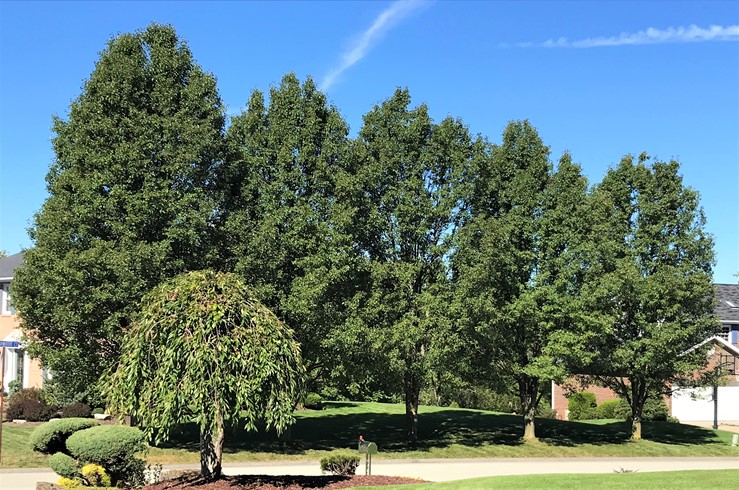
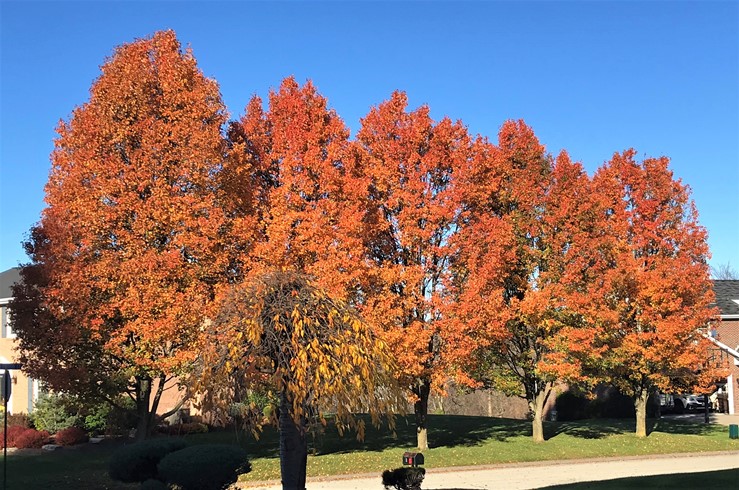
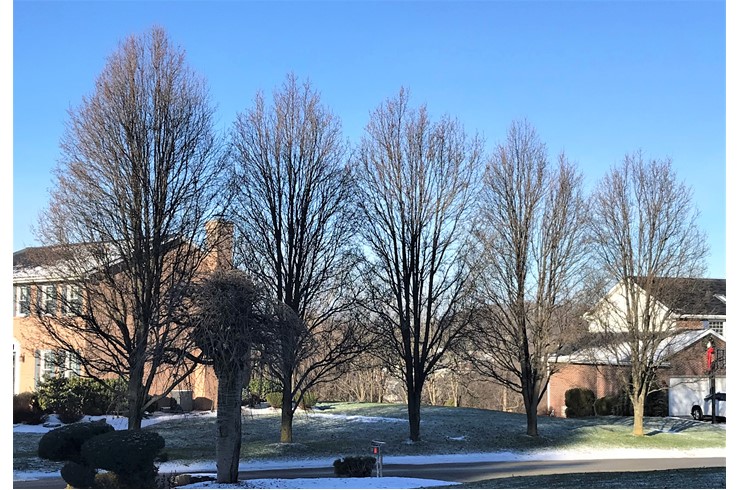
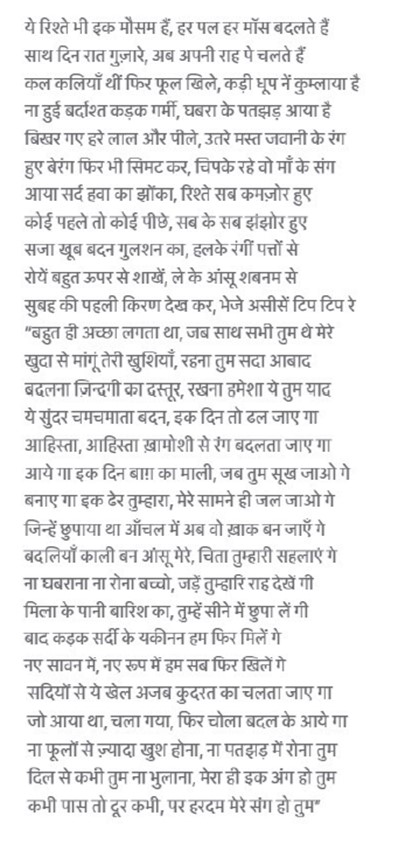
Relations are seasons, changing each moment, every month
Spent days n nights together — now on own paths
Buds yesterday, then flowers bloomed, withered by sunshine
Couldn’t tolerate the blistering heat; then nervously Fall arrived
Scattered green, red & yellow, the intoxicated youthful colors faded
Colorless they wound up, staying connected with their mother
Came one gust of cold wind, all relations weakened
Some first others later, all got shaken
And the garden’s body decorated by faded colored leaves
Cried branches from above, drawing tears from dew
First ray of sunshine, sent blessings — drip drip drip
“Felt very good when you were with me
Asked God for your joy, may you live forever
Change is way of life, you always must remember
This shiny body, one day will weaken
Silently slowly this color will keep changing
One day gardener will come when you’re fully dry
Piled into a heap, you will burn in front of my eyes
Not too long ago, I hid you in my lap; now you become ashes
Black clouds become teardrops, and caress your pyre
Don’t worry or cry, my children, roots will look for you
Mixing with rain water, they will hide you inside my bosom
After bitter cold surely we will meet again
In new spring, in new form, we will bloom again
For centuries this play of nature will go on
One who came, left, then returns in altered garb
Don’t be overjoyed in Spring — nor cry in Fall
Never forget in your heart, you’re my body part.
Home:
Obituary: Tandav Magge (1932 to July 24, 2020)
Posted by admin in January 2021, Past issues on December 29, 2020
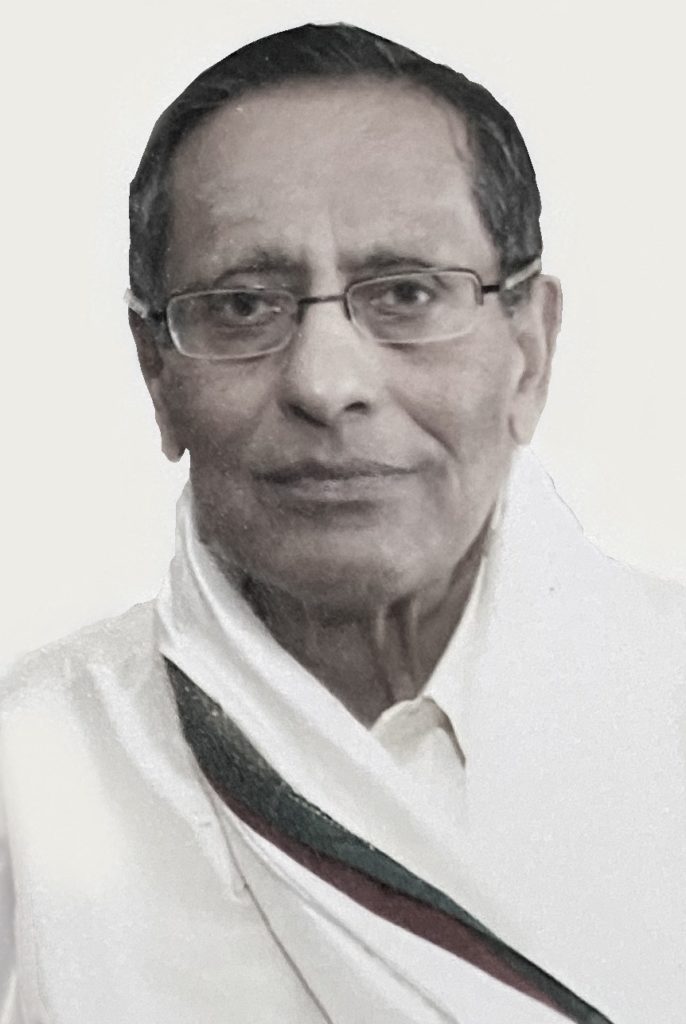
Tandaveswara (Tandav) Subramanyam Magge was born in Mysore, India on March 1,1932 to Hosakote Seethalakshamma and Subramanyam N. Magge. Tandav was the second of five children. His sisters Krishnaveni and Shashi are now deceased; and Tandav now is survived by his younger brothers Natesh and Shankar. When Tandav was 15, his father passed away and his brother-in-law M.R. Lakshminarayana stepped in to raise him and take care of his education and upbringing.
After completing his Bachelor of Science and Bachelor of Engineering degrees from the University of Mysore, Tandav came to the U.S. in 1961 to continue his education and join his brother. He had a very special bond with his brothers and sisters’ children and their families. As such, he worked very hard to bring the next generation of the family to join him in America.
Tandav received a master’s degree in industrial engineering from New York University and a master’s in mechanical engineering from Northeastern University. He worked at Curtiswright and General Electric for over 12 years designing aircraft engines. He then held a long and distinguished career for over 35 years at Westinghouse Electric Company in Pittsburgh, before retiring in 2012.
He was dedicated to his wife of 65 years, Susheela, as well as their children — Lakshmi an internist (and husband Ramesh, a cardiologist), Keshav, a plastic surgeon (married to Monica, a Marketing consultant), and Sandya, a financial services executive (married to Ketan, a lawyer).
His daughter, Lakshmi, was tirelessly dedicated to her father’s medical care, serving as his physician for over 30 years. He adored his grandchildren Anita, Ashwin, Lila, Veda, Zane, and great grandson, Niam. He was able to meet his newest grandson, Rohan, shortly before he passed away.
Tandav was grateful for his Pittsburgh community of friends and supporters. He was a dedicated/hardcore fan of all Pittsburgh sports including football, baseball and hockey. He passed away at his home on the night of July 24th with his family by his side. He will forever be missed, but his legacy will never be forgotten. — Submitted by Mr. Tandav Magge’s loving family members

